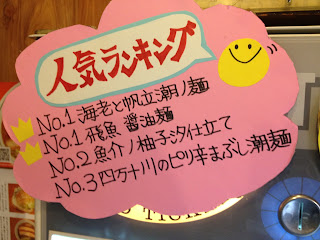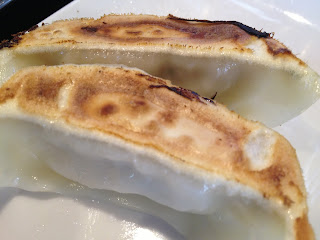Today, the Buta-oh, or "King of Pigs," was calling us. Nagi serves up a solid Hakata-style tonkotsu ramen.
 |
| Akatama (880yen) |
Overall, a nice and spicy bowl, though the red hot stuff mutes the flavor of the pork a bit too much for my taste.
In the past, I've ordered the kuro-tama, or "black ball" bowl, which is a lump of pork infused with burnt garlic oil. But on this sweltering summer mid-day, the hiyashi (chilled) tonkotsu seemed like the perfect recipe for cold and crazy delicious.
 |
| Hiyashi tonkotsu (850yen) |
Some shops will offer bowls of cold noodles during the summer months as a limited-time offering (this isn't unusual to residents of Korea, but cold ramen is much less abundant in Japan). Filled with ice cubes, green vegetables, umeboshi pickled plum, and steamed, cold shabu shabu-like pork, this cold tonkotsu seemed like a strong idea...
...felled by meek execution. The thin noodles - a staple of any good Hakata bowl - were a bad match for the soup, which was strangely sour. The steamed pork was rubbery and flavorless. Rather than quench my ramen thirst, it made me long for another bowl immediately.
Adding insult to injury is how much this bowl cost - 850 yen is steep for Hakata ramen, even if it's only served for a limited-time. Bowls of tonkotsu are meant to be cheap so you can order a kaedama, which is another round of thin noodles to finish off the soup. But at 750 yen for even their simplest bowl, I don't see how anyone can be satiated with Buta-oh without shelling out a premium.
Nagi has been great in the past. They are capable of more.
Tokyo, Shibuya-ku, East 1-3-1 Caminito 1F
Closest stn: Shibuya (8 min walk)
Open from 1130am-4pm and 5-9pm
Hearts

















































